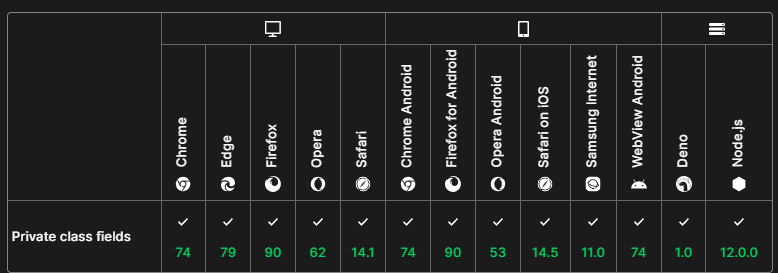class
方法
原型方法和实例方法的区别
js
// es6
class Employee {
constructor(name, age) {
this.name = name
this.age = age
this.eat = () => { // 实例方法
console.log(`${this.name} eat`)
}
}
say() { // 类的原型方法
console.log(`${this.name} ${this.age}`)
}
}
// es5
function Employee(name, age) {
this.name = name
this.age = age
this.eat = () => { // 实例方法
console.log(`${this.name} eat`)
}
}
Employee.prototype.say = function () { // 原型方法
console.log(`${this.name} ${this.age}`)
}// es6
class Employee {
constructor(name, age) {
this.name = name
this.age = age
this.eat = () => { // 实例方法
console.log(`${this.name} eat`)
}
}
say() { // 类的原型方法
console.log(`${this.name} ${this.age}`)
}
}
// es5
function Employee(name, age) {
this.name = name
this.age = age
this.eat = () => { // 实例方法
console.log(`${this.name} eat`)
}
}
Employee.prototype.say = function () { // 原型方法
console.log(`${this.name} ${this.age}`)
}TIP
在构造器外定义的方法是原型方法,定义的变量是实例属性
类私有域
类属性在默认情况下是公有的,但可以使用增加哈希前缀 # 的方法来定义私有类字段
js
class Person {
#privateField
static #PRIVATE_STATIC_FIELD // 私有静态属性
constructor() {
this.#privateFiled = 52
Person.#PRIVATE_STATIC_FIELD = 42
}
#privateMethod() {
return 'hello world'
}
static #privateStaticMethod() { // 私有静态方法
return 42
}
}class Person {
#privateField
static #PRIVATE_STATIC_FIELD // 私有静态属性
constructor() {
this.#privateFiled = 52
Person.#PRIVATE_STATIC_FIELD = 42
}
#privateMethod() {
return 'hello world'
}
static #privateStaticMethod() { // 私有静态方法
return 42
}
}TIP
可以使用 in 运算符检查私有字段(或私有方法)是否存在。当私有字段或私有方法存在时,运算符返回 true,否则返回 false。
